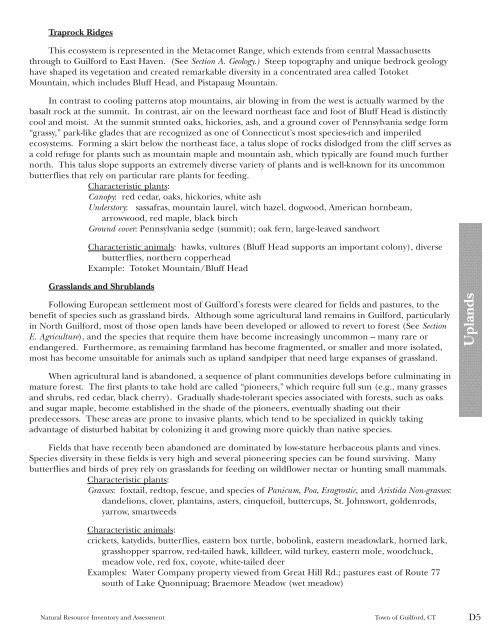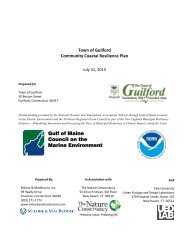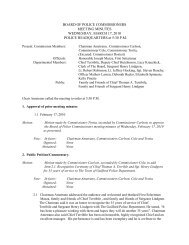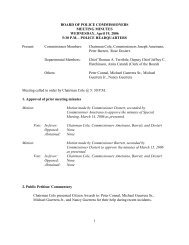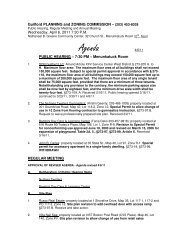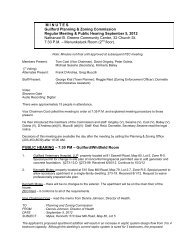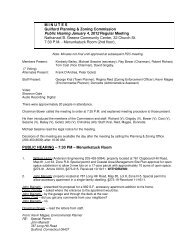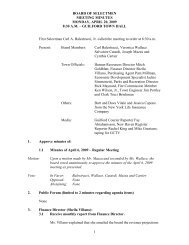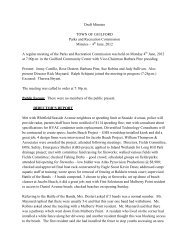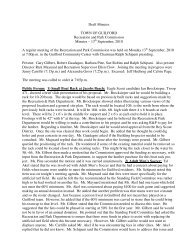Natural Resource Inventory and Assessment - Town of Guilford
Natural Resource Inventory and Assessment - Town of Guilford
Natural Resource Inventory and Assessment - Town of Guilford
You also want an ePaper? Increase the reach of your titles
YUMPU automatically turns print PDFs into web optimized ePapers that Google loves.
Traprock Ridges<br />
This ecosystem is represented in the Metacomet Range, which extends from central Massachusetts<br />
through to <strong>Guilford</strong> to East Haven. (See Section A. Geology.) Steep topography <strong>and</strong> unique bedrock geology<br />
have shaped its vegetation <strong>and</strong> created remarkable diversity in a concentrated area called Totoket<br />
Mountain, which includes Bluff Head, <strong>and</strong> Pistapaug Mountain.<br />
In contrast to cooling patterns atop mountains, air blowing in from the west is actually warmed by the<br />
basalt rock at the summit. In contrast, air on the leeward northeast face <strong>and</strong> foot <strong>of</strong> Bluff Head is distinctly<br />
cool <strong>and</strong> moist. At the summit stunted oaks, hickories, ash, <strong>and</strong> a ground cover <strong>of</strong> Pennsylvania sedge form<br />
“grassy,” park-like glades that are recognized as one <strong>of</strong> Connecticut’s most species-rich <strong>and</strong> imperiled<br />
ecosystems. Forming a skirt below the northeast face, a talus slope <strong>of</strong> rocks dislodged from the cliff serves as<br />
a cold refuge for plants such as mountain maple <strong>and</strong> mountain ash, which typically are found much further<br />
north. This talus slope supports an extremely diverse variety <strong>of</strong> plants <strong>and</strong> is well-known for its uncommon<br />
butterflies that rely on particular rare plants for feeding.<br />
Characteristic plants:<br />
Canopy: red cedar, oaks, hickories, white ash<br />
Understory: sassafras, mountain laurel, witch hazel, dogwood, American hornbeam,<br />
arrowwood, red maple, black birch<br />
Ground cover: Pennsylvania sedge (summit); oak fern, large-leaved s<strong>and</strong>wort<br />
Characteristic animals: hawks, vultures (Bluff Head supports an important colony), diverse<br />
butterflies, northern copperhead<br />
Example: Totoket Mountain/Bluff Head<br />
Grassl<strong>and</strong>s <strong>and</strong> Shrubl<strong>and</strong>s<br />
Following European settlement most <strong>of</strong> <strong>Guilford</strong>’s forests were cleared for fields <strong>and</strong> pastures, to the<br />
benefit <strong>of</strong> species such as grassl<strong>and</strong> birds. Although some agricultural l<strong>and</strong> remains in <strong>Guilford</strong>, particularly<br />
in North <strong>Guilford</strong>, most <strong>of</strong> those open l<strong>and</strong>s have been developed or allowed to revert to forest (See Section<br />
E. Agriculture), <strong>and</strong> the species that require them have become increasingly uncommon – many rare or<br />
endangered. Furthermore, as remaining farml<strong>and</strong> has become fragmented, or smaller <strong>and</strong> more isolated,<br />
most has become unsuitable for animals such as upl<strong>and</strong> s<strong>and</strong>piper that need large expanses <strong>of</strong> grassl<strong>and</strong>.<br />
When agricultural l<strong>and</strong> is ab<strong>and</strong>oned, a sequence <strong>of</strong> plant communities develops before culminating in<br />
mature forest. The first plants to take hold are called “pioneers,” which require full sun (e.g., many grasses<br />
<strong>and</strong> shrubs, red cedar, black cherry). Gradually shade-tolerant species associated with forests, such as oaks<br />
<strong>and</strong> sugar maple, become established in the shade <strong>of</strong> the pioneers, eventually shading out their<br />
predecessors. These areas are prone to invasive plants, which tend to be specialized in quickly taking<br />
advantage <strong>of</strong> disturbed habitat by colonizing it <strong>and</strong> growing more quickly than native species.<br />
Fields that have recently been ab<strong>and</strong>oned are dominated by low-stature herbaceous plants <strong>and</strong> vines.<br />
Species diversity in these fields is very high <strong>and</strong> several pioneering species can be found surviving. Many<br />
butterflies <strong>and</strong> birds <strong>of</strong> prey rely on grassl<strong>and</strong>s for feeding on wildflower nectar or hunting small mammals.<br />
Characteristic plants:<br />
Grasses: foxtail, redtop, fescue, <strong>and</strong> species <strong>of</strong> Panicum, Poa, Eragrostic, <strong>and</strong> Aristida Non-grasses:<br />
d<strong>and</strong>elions, clover, plantains, asters, cinquefoil, buttercups, St. Johnswort, goldenrods,<br />
yarrow, smartweeds<br />
Characteristic animals:<br />
crickets, katydids, butterflies, eastern box turtle, bobolink, eastern meadowlark, horned lark,<br />
grasshopper sparrow, red-tailed hawk, killdeer, wild turkey, eastern mole, woodchuck,<br />
meadow vole, red fox, coyote, white-tailed deer<br />
Examples: Water Company property viewed from Great Hill Rd.; pastures east <strong>of</strong> Route 77<br />
south <strong>of</strong> Lake Quonnipuag; Braemore Meadow (wet meadow)<br />
<strong>Natural</strong> <strong>Resource</strong> <strong>Inventory</strong> <strong>and</strong> <strong>Assessment</strong> <strong>Town</strong> <strong>of</strong> <strong>Guilford</strong>, CT D5<br />
Upl<strong>and</strong>s


